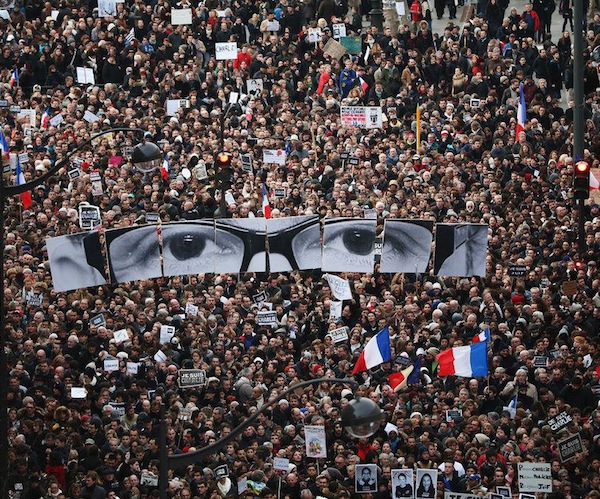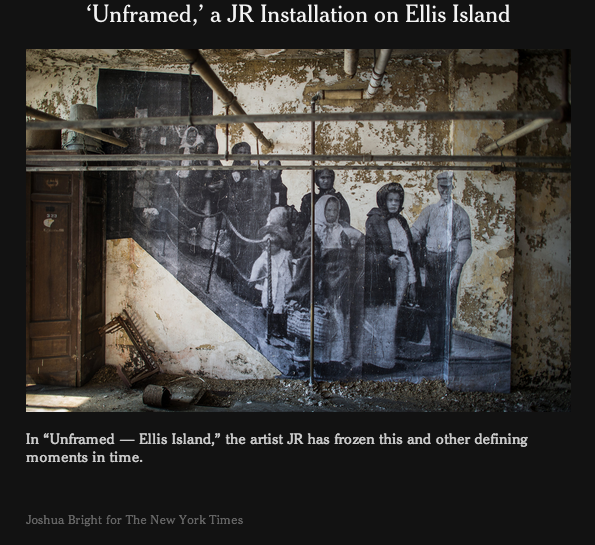Visual Arts Commentary: The Telling Anonymity of Political Street Art
Highlighting the identity of artists is essential in art world journalism, but it appears to be unimportant when reporting on the artistic contributions to political street demonstrations.

(Source: http://www.nytimes.com/2015/01/12/world/europe/paris-march-against-terror-charlie-hebdo.html#slideshow/100000003442449/100000003442460)
By John Bell
This past Sunday’s march against terror in France, which drew over a million people into the streets of Paris to protest the slaughter of the previous days, featured an eight-panel photographic portrait of the eyes of Charlie Hebdo editor Stéphane Charbonnier. A photograph of this giant performing object graced the front page of the print edition of the Monday, January 12th issue of the New York Times. The image was also featured on the publication’s website. But nowhere did the NYTimes identify this spectacular street art as the work of French artist known as JR. JR’s work had appeared on the streets of New York City four weeks earlier, on December 12, again in the form of eight-panel giant photo portraits. But that time his work — representing the eyes of Michael Brown and Eric Garner — was part of the Millions March NYC. The Times also featured a photograph of this stunning street art the next day.

(Source: http://www.nytimes.com/2014/12/14/nyregion/in-new-york-thousands-march-in-continuing-protests-over-garner-case.html?smid=pl-share&_r=0#)
Although giant performing objects of all sorts have for many centuries been essential to street processions expressing official, religious, festival, or anti-establishment points of view, it is interesting to note that in the two recent manifestations of JR’s work — which have garnered global recognition — he is not identified as the creator of these potent political performing objects by the NY Times and other press and media sources.
For the New York Times and other mass/mainstream media news outlets, JR’s very visible, popular, and effective processional street art, like much street art, is not deemed worthy of being noticed, identified, or analyzed in the same way that the art in galleries or museums is.
Ironically, the French artist’s work was analyzed by the Times on September 24, 2014 when its Arts section devoted an entire article to JR’s Ellis Island installation, also based on large-scale photographic prints.
Why haven’t the New York Times and other news sources been able to connect JR’s September Ellis Island work to the eye portraits of Eric Garner and Michael Brown in New York and the Stéphane Charbonnier eye portrait in Paris? Isn’t it newsworthy that JR’s processional art in these two globally important street demonstrations reached millions more people than those who saw his Ellis Island installation?

(Source: http://www.nytimes.com/2014/09/25/arts/design/jr-brings-ellis-islands-abandoned-hospital-to-life.html#slideshow/100000003133715/100000003133744)
While underlining the identity of artists is essential in art world journalism, it appears to be unimportant when reporting on the artistic contributions to political street demonstrations. JR’s political street art is especially notable at the moment: he has been active almost simultaneously in Europe and the U.S. in the context of both the Black Lives Matter movement and the Je Suis Charlie demonstrations. This is a situation that is probably unique in the history of modern street performance. JR’s TED talk
The erasure of JR’s role in New York Times coverage of his street art reflects the ideology of the art market and arts criticism: while art presented in the contexts of exhibitions and museums is easily recognized as culturally and economically valuable, especially when attached to the name of a recognized artist, art created to express political beliefs in public spaces is considered neither culturally or economically important. Thus it is not worth the legitimatizing gaze of mass media attention. Of course, this blindness offers further proof that mainstream media outlets such as the NYTimes don’t fully understand the nature of 21st-century culture.
John Bell is Director of the Ballard Institute and Museum of Puppetry and an Associate Professor of Dramatic Arts, both at the University of Connecticut. He is a member of Great Small Works theater company, and a veteran of Bread & Puppet Theater. He recently co-edited The Routledge Companion to Puppetry and Material Performance.
Tagged: John Bell, Jr, new-york-times, political street demonstrations, street art
